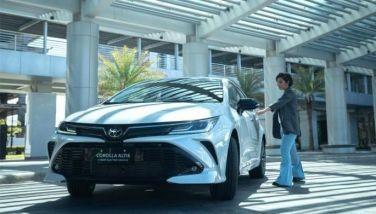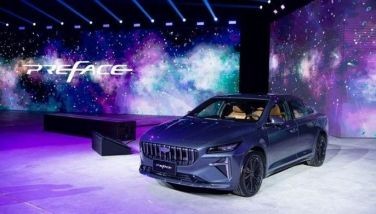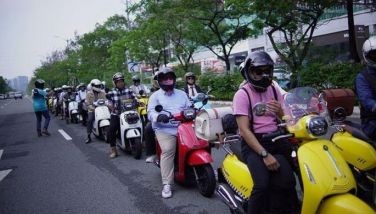Scaling this Everest
December 17, 2003 | 12:00am
Once upon a time, there was an automobile called the Sport Utility Vehicle. It was neither a pickup truck nor a station wagon, but it tried to be both. It didn’t look like much and it didn’t cost too much, but it got the job done. It could pull trailers, slog through mud, take a beating, and generally be the dirty little bastar... err, workhorse man used to get him places where roads were at a premium. Then it moved up in the social food chain. It went to engineering school and came back with little diplomas like "Limited Slip Differential" and "Monocoque" and "Full-time All Wheel Drive". But then it also got sent to charm school, where it took up courses in "Leather Upholstery" and "Cupholders", also taking the time to dabble in "Simulated Woodgrain". So now it’s a pretty civilized beast.
The Sport Utility Vehicle has gone forth and multiplied to the delight of oil companies, manufacturers, and folks who like to think they’re the "outdoorsy" kind of people just because they can wade floods where the family car can’t.
Surprise, surprise, the Ford Everest is not that kind of Sport Utility Vehicle. It’s not terribly pretty, nor saddled with ultra modern technology that will impress neighbors and colleagues. It’s an SUV of pretty much the original formula, and if you don’t like it...well, try out Ford’s Escape then or similar SUVs from the competition. No, no, it has the basic, hard core SUV traits in a modern, smoothed out package so you won’t hurt yourself having fun out in the boonies. Namely: a torquey engine, a manual transmission, part-time four wheel drive with a Low range, a body-on-frame chassis and a Limited Slip Differential.
You’d have to be blind not to guess the Everest’s origins. Walk a few meters away from an Everest in a Ford dealership and you’ll bump into its daddy, the Ranger pickup truck. It has practically the same hardware specs, but some differences are in order. This isn’t just a Ranger with an extended roof and a few extra seats. Indeed, with seating for seven in the Everest’s longish chassis, few complaints will be heard as long as you mind the stiff springs. They’re not any stiffer than in your average pickup truck or AUV, but people spoiled for the Escape or CR-V or RAV4’s softer suspensions should know what they’re getting with the Everest: front double wishbones and rear leaf springs.
And don’t expect an automatic transmission or gasoline engine either. The only powertrain available (so far) is a turbocharged and intercooled, 2.5-liter diesel with 112 PS and 270 Newton-meters of torque. If you’re familiar with how turbodiesels work, it won’t be a problem going around town at a fast clip. If you’re not, you’ll complain about the turbo lag below 2,000 rpm, the wide shift gate, the noise, the low redline and other diesel truck traits that gasoline snobs like me whine about. But with the right kind of driving style, the Everest will quickly take you places few car-based SUVs dare. The power steering seems to have a lighter effort than the Ranger too, and pedal action is communicative and firm. This isn’t a mountain to drive, but the size of the thing is empowering — and just a little intimidating nonetheless. Urban commuter, the Everest is not.
As a modern multipurpose vehicle, however, the Everest has got practically everything covered. Power everything, rear backup sensors, a nice in-dash CD player, bucket seats, cupholders, 3-section airconditioning... blah-blah-blah? Few people will complain about such creature comforts, but the Everest is a solid utility vehicle underneath it all. Fabric upholstery means it’s easier to clean and more breathable than plush leather, and the body-on-frame chassis will take more abuse than a monocoque. The part-time four wheel drive takes more presence of mind to use judiciously than a fully automatic system, but that Low range is worth its weight in gold when the terrain becomes seriously bad. And that’s really good if you’re one of those hard-core off-roaders whose idea of fun is crossing rivers and traversing fallen trees during the weekend.
Need more space this coming election season? Fold the rear seats or take out the rearmost bench. Now you’ve probably got more cubic space than a Ranger’s bed (at the cost of passenger space, of course), a roof to protect your gear from the elements, and airconditioning to keep the dead bodies cool. Don’t forget the tie-down thingamajigs and the auxiliary power point. Build quality is good, but not fine.
Hey, it’s a workhorse. You know, something you drive to the countryside, rough up on the farm, roll around with in the mud, then hose everything off afterward. That kind of SUV. Other stuff like dual airbags, 4-wheel ABS, and leather wrapped steering wheel and shifter just make it a nicer and safer, utility vehicle to drive. At P1,210,000, this 4x4 is a little more expensive than a 4WD Escape with the 2.0-liter engine. But that Ford is made for about 80 percent of what people expect an SUV to do for them these days. This Ford, on the other hand, seems more suited for the remaining 20, when climbing a mountain just might be on the day’s agenda.
The Sport Utility Vehicle has gone forth and multiplied to the delight of oil companies, manufacturers, and folks who like to think they’re the "outdoorsy" kind of people just because they can wade floods where the family car can’t.
Surprise, surprise, the Ford Everest is not that kind of Sport Utility Vehicle. It’s not terribly pretty, nor saddled with ultra modern technology that will impress neighbors and colleagues. It’s an SUV of pretty much the original formula, and if you don’t like it...well, try out Ford’s Escape then or similar SUVs from the competition. No, no, it has the basic, hard core SUV traits in a modern, smoothed out package so you won’t hurt yourself having fun out in the boonies. Namely: a torquey engine, a manual transmission, part-time four wheel drive with a Low range, a body-on-frame chassis and a Limited Slip Differential.
You’d have to be blind not to guess the Everest’s origins. Walk a few meters away from an Everest in a Ford dealership and you’ll bump into its daddy, the Ranger pickup truck. It has practically the same hardware specs, but some differences are in order. This isn’t just a Ranger with an extended roof and a few extra seats. Indeed, with seating for seven in the Everest’s longish chassis, few complaints will be heard as long as you mind the stiff springs. They’re not any stiffer than in your average pickup truck or AUV, but people spoiled for the Escape or CR-V or RAV4’s softer suspensions should know what they’re getting with the Everest: front double wishbones and rear leaf springs.
And don’t expect an automatic transmission or gasoline engine either. The only powertrain available (so far) is a turbocharged and intercooled, 2.5-liter diesel with 112 PS and 270 Newton-meters of torque. If you’re familiar with how turbodiesels work, it won’t be a problem going around town at a fast clip. If you’re not, you’ll complain about the turbo lag below 2,000 rpm, the wide shift gate, the noise, the low redline and other diesel truck traits that gasoline snobs like me whine about. But with the right kind of driving style, the Everest will quickly take you places few car-based SUVs dare. The power steering seems to have a lighter effort than the Ranger too, and pedal action is communicative and firm. This isn’t a mountain to drive, but the size of the thing is empowering — and just a little intimidating nonetheless. Urban commuter, the Everest is not.
As a modern multipurpose vehicle, however, the Everest has got practically everything covered. Power everything, rear backup sensors, a nice in-dash CD player, bucket seats, cupholders, 3-section airconditioning... blah-blah-blah? Few people will complain about such creature comforts, but the Everest is a solid utility vehicle underneath it all. Fabric upholstery means it’s easier to clean and more breathable than plush leather, and the body-on-frame chassis will take more abuse than a monocoque. The part-time four wheel drive takes more presence of mind to use judiciously than a fully automatic system, but that Low range is worth its weight in gold when the terrain becomes seriously bad. And that’s really good if you’re one of those hard-core off-roaders whose idea of fun is crossing rivers and traversing fallen trees during the weekend.
Need more space this coming election season? Fold the rear seats or take out the rearmost bench. Now you’ve probably got more cubic space than a Ranger’s bed (at the cost of passenger space, of course), a roof to protect your gear from the elements, and airconditioning to keep the dead bodies cool. Don’t forget the tie-down thingamajigs and the auxiliary power point. Build quality is good, but not fine.
Hey, it’s a workhorse. You know, something you drive to the countryside, rough up on the farm, roll around with in the mud, then hose everything off afterward. That kind of SUV. Other stuff like dual airbags, 4-wheel ABS, and leather wrapped steering wheel and shifter just make it a nicer and safer, utility vehicle to drive. At P1,210,000, this 4x4 is a little more expensive than a 4WD Escape with the 2.0-liter engine. But that Ford is made for about 80 percent of what people expect an SUV to do for them these days. This Ford, on the other hand, seems more suited for the remaining 20, when climbing a mountain just might be on the day’s agenda.
BrandSpace Articles
<
>
- Latest
Latest
Latest
August 16, 2024 - 11:00am
By Euden Valdez | August 16, 2024 - 11:00am
June 18, 2024 - 2:55pm
June 18, 2024 - 2:55pm
Recommended

























